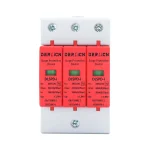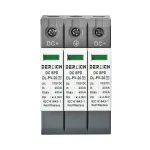In today’s power systems, surge protection is no longer optional—it’s essential. Whether you’re protecting your home, business, or renewable energy system, installing the right Surge Protection Device (SPD) can save your equipment from costly damage. But here’s a question that often arises:
Can I use an AC SPD for a DC power system?
The short answer is no—and using the wrong type can be dangerous. Let’s dive into why AC and DC SPDs are not interchangeable and how to choose the correct one for your system.
What is a Surge Protection Device (SPD)?
A Surge Protection Device is designed to protect electrical installations and connected equipment from transient overvoltages—commonly caused by lightning strikes, switching events, or power grid disturbances.
SPDs work by clamping excessive voltage and diverting the surge current safely to the ground, preventing damage to sensitive electronics and insulation failure.
There are two primary types of SPDs based on the current they protect:
-
AC SPDs – used in alternating current systems (e.g., homes, offices, factories).
-
DC SPDs – used in direct current systems (e.g., solar PV systems, batteries, EV chargers).

AC SPD

DC SPD
Understanding AC Power and AC SPDs
AC power alternates direction, typically at 50Hz or 60Hz. The voltage waveform is sinusoidal, and it crosses the zero-voltage line twice per cycle.
Because of this natural zero-crossing behavior, AC SPDs can easily suppress arcs and reset after an overvoltage event. Their design focuses on handling repetitive surges, grid transients, and protecting equipment like:
Switchboards
HVAC systems
Lighting panels
Computers and office electronics
Understanding DC Power and DC SPDs
DC power flows in a single, constant direction. It is common in solar energy systems, battery backups, electric vehicles, and industrial automation.
The challenge with DC is the lack of zero crossing, which makes it harder to extinguish electrical arcs. As a result, DC SPDs are built with specialized arc-suppression technologies and must withstand continuous high voltage without reset failure.
Applications requiring DC SPDs include:
Solar combiner boxes and inverters
Battery energy storage systems (BESS)
Off-grid and hybrid renewable setups
EV fast charging stations
AC SPD vs. DC SPD: Key Differences Summarized
⚠ Using an AC SPD in a DC system can lead to fire hazards, insulation breakdown, or SPD explosion.
Why You CANNOT (Safely) Use an AC SPD for DC Power
Many assume surge protectors are universal—but they’re not. Here’s why AC SPDs must never be used for DC:
No Arc Suppression: AC SPDs rely on current zero-crossing to interrupt arcs. Without this, the device may fail catastrophically in DC systems.
Wrong Voltage Clamping: The clamping levels are optimized for AC RMS voltages. Applying them to DC systems could result in inadequate protection or premature failure.
Internal Component Damage: Varistors, spark gaps, or MOVs inside AC SPDs are not designed to handle continuous unidirectional current.
Violates Electrical Standards: Installation of mismatched SPDs may void certifications and breach safety codes such as UL 1449 or IEC 61643.
If your system is DC, always use a properly rated DC SPD.
Can You Use a DC SPD for AC Power?
Technically, some DC SPDs may handle AC voltages, especially if their components are dual-rated. However, using a DC SPD for AC circuits is still not recommended unless explicitly approved by the manufacturer.
Best practice: Only use SPDs designed and certified for the specific power type in your system.
How to Choose the Correct SPD
To ensure safe and reliable protection, follow these tips:
✅ Identify whether your system uses AC or DC
✅ Check the system voltage (e.g., 230V AC, 1000V DC)
✅ Choose the correct SPD type (Type 1, Type 2, or Type 3)
✅ Ensure the short-circuit withstand rating (SCCR) is sufficient
✅ For solar PV systems, select SPDs compliant with IEC 61643-31 or UL 1449 4th Ed.
If you’re unsure, always consult your supplier or electrical engineer.
Derlicn Electric: Your Partner in Surge Protection
At Derlicn Electric, we provide a wide range of AC and DC SPDs engineered for high performance and long-term safety. Whether you need protection for a grid-tied solar system, commercial building, or EV charger, we’ve got a solution that fits.
We offer:
Type 1, Type 2, and hybrid SPDs
DC SPDs up to 1500V for solar applications
Customizable solutions for OEM/ODM needs
Compliance with CE, TUV, and UL standards
📩 Contact us now to request a free catalog or technical consultation.
Conclusion
Understanding the difference between AC and DC SPDs is not just technical—it’s essential for safety. The two are not interchangeable. Always match the SPD to your power type, and never compromise on surge protection quality.
Protect smarter. Choose wisely. Power safely—with Derlicn Electric.
Table of Contents
Have you Any Questions?
Can’t find an answer to your question, or want more information about our products? If so, please feel free to get in touch with our professional team. We’re here to help you drive your projects to success.
